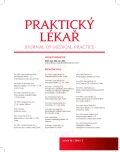Overview of questionnaires and scales of the motor symptoms of patients with Parkinson’s disease
Authors:
R. Kozáková; R. Bužgová; R. Zeleníková; L. Sikorová
Authors‘ workplace:
Vedoucí: prof. PhDr. Darja Jarošová, Ph. D.
; Lékařská fakulta
; Ústav ošetřovatelství a porodní asistence
; Ostravská univerzita v Ostravě
Published in:
Prakt. Lék. 2018; 98(3): 116-120
Category:
Of different specialties
Overview
Due to the progression and specific symptoms of the disease, it is advisable to provide multidisciplinary care for Parkinson’s disease (PN) patients in order to maintain the best quality of life both for the patient and their family. Abroad, questionnaires and scales are used to assess the patient’s health condition, to determine disease progression and to provide follow-up personalized care. The aim of this review article is to describe and analyse the scales used in evaluating PN patients’ motor function. 22 scales designed for PN patients were found in the electronic databases. The MDS-UPDRS (Movement Disorder Society Unified Parkinson’s Disease Rating Scale) is the most commonly used scale to assess functional status. The use of this scale is recommended in clinical practice as well as in research.
Keywords:
Parkinson disease – questionnaires – quality of life – multidisciplinary care – scales
Sources
1. Bednařík J, Ambler Z, Růžička E, a kol. Klinická neurologie – část spe-ciální I. Praha: Triton 2010.
2. Brown RG, MacCarthy B, Jahanshahi M, Marsden CD. Accuracy of self-reported disability in patients with parkinsonism. Arch Neurol 1989; 46(9): 955–959.
3. Cooperative Multicentric Group, Martínez-Martin P, Gil-Nagel A, Morlán Gracia L, et al. Intermediate scale for assessment of Parkinson’s disease. Characteristics and structure. Parkinsonism Relat Disord 1995; 1(2): 97–102.
4. Duvoisin RC. The evaluation of extrapyramidal disease. In: De Ajuriaguerra J, Gauthier G. (eds.) Monoamines, noyaux gris centraux et de syndrome de Parkinson. Masson: Paris 1971; 313–325.
5. Elman LB, Houghton DJ, WU GF, et al. Palliative care in amyotrophic lateral sclerosis, Parkinson´s disease, and multiple sclerosis. J Palliat Med 2007; 10(2): 433–457.
6. García-Ruiz PJ, Del Val J, Fernández IM, Herranz A. What factors influence motor complications in Parkinson disease? – a 10 year prospective study. Clin Neuropharmacol 2012; 35: 1–5.
7. Goetz CC. The Unified Parkinson’s Disease Rating Scale (UPDRS): status and recommendations. Mov Disord 2003; 18(7): 738–750.
8. Goetz CG, Fahn S, Martinez-Martinin P, et al. Movement Disorder Society – sponsored revision of the unified Parkinson’s disease rating scale (MDS-UPDRS): process, format and clinimetric testing plan. Mov Disord 2007; 22: 41–47.
9. Goetz CG, Nutt JG, Stebbins GT. The unified dyskinesias rating scale: presentation and clinimetric profile. Mov Disord 2008; 23(16): 2398–2403.
10. Goetz CG, Stebbins GT, Shale HM, et al. Utility of an objective dyskinesia rating scale for Parkinson’s disease: inter- and intrarater reliability assessment. Mov Disord 1994; 9(4): 390–394.
11. Guy W. ECDEU assessment manual for psychopharmacology. Washington, DC: Governement Printing Office 1976.
12. Hagell P, Widner H. Clinical rating of dyskinesias in Parkinson’s disease: utility and reliability of a new rating scale. Mov Disord 1999; 14(3): 448–455.
13. Hauser RA, Friedlander J, Zesiewicz TA, et al. A home diary to assess functional status in patients with Parkinsonś disease with motor fluctuations and dyskinesia. Neuropharmacol 2000; 23(2): 75–81.
14. Hobson JP, Edwards NI, Meara RJ. The Parkinson’s disease Activities of Daily Living Scale: a new simple and brief subjective measure of disability in Parkinson’s disease. Clin Rehabil 2001; 15(3): 241–246.
15. Hoehn MM, Yahr MD. Parkinsonism: onset, progression and mortality. Neurology 1967; 17(5): 427–442.
16. Katzenschlager R, Schrag A, Evans A, et al. Quantifying the impact of dyskinesias in PD. The PDYS-26: a patient-based outcome measure. Neurology 2007; 69(6): 555–563.
17. Marinus J, Visser M, Stiggelbout AM, et al. Activity-based diary for Parkinson‘s disease. Clin Neuropharmacol 2002; 25(1): 43–50.
18. Martinez-Martin P, Tolosa E, Hernandez B, et al. Validation of the „QUICK“ questionnaire – A tool for diagnosis of „wearing-off“ in patients with Parkinson’s disease. Mov Disord 2008; 23(6): 830–836.
19. Parkinson Study Group. Evaluation of dyskinesias in a pilot, randomized, placebo-controlled trial of remacemide in advanced Parkinson disease. Arch Neurol 2001; 58(10): 1660–1668.
20. Ramaker C, Marinus J, Stiggelbout AM, van Hilten BJ. Systematic evaluation of rating scales for impairment and disability in Parkinson´s disease. Mov Disord 2002; 17(5): 867–876.
21. Reimer J, Grabowski M, Lindvall O, Hagell P. Use and interpretation of on/off diaries in Parkinson’s disease. J Neurol Neurosurg Psychiatry 2004; 75(3): 396–400.
22. Schwab RS, England AC. Projection technique for evaluating surgery in Parkinson’s disease. In: Gillingham FJ, Donaldson IML. (eds.) Third symposium on Parkinson’s disease. Edinburgh: E. and S. Livingstone 1969; 152–157.
23. von Campenhausen S, Bornschein B, Wick R, et al. Prevalence and incidence of Parkinson’s disease in Europe. Eur Neuropsychopharmacol 2005; 15(4): 473–490.
24. Stacy M, Hauser, R. Development of a patient questionnaire to facilitate recognition of motor and non-motor wearing-off in Parkinson’s disease. J Neural Transm 2007; 114(2): 211–217.
25. Stacy MA, Murphy JM, Greeley DR, et al. The sensitivity and specificity of the 9-item Wearing-off Questionnaire. Parkinsonism Relat Disord 2008; 14(3): 205–212.
26. Webster D. Critical analysis of the disability of Parkinson’s disease. Mod Treat 1968; 5(2): 393–397.
Labels
General practitioner for children and adolescents General practitioner for adultsArticle was published in
General Practitioner

2018 Issue 3
Most read in this issue
- Preoperative anaemia: prevalence, causes, consequences, and management
- Overview of questionnaires and scales of the motor symptoms of patients with Parkinson’s disease
- Treatment of immunodeficiency by subcutaneous immunoglobulins
- Basics of respiratory physiotherapy for general practitioners
